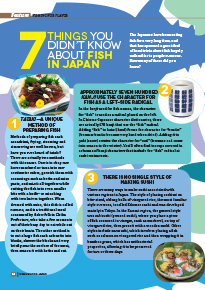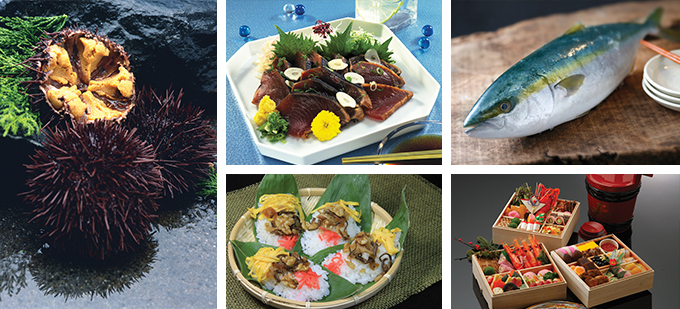Home > Highlighting JAPAN >Highlighting Japan July 2015>Fishing for Flavor
Highlighting JAPAN

Fishing for Flavor
7 Things you didn’t know about fish in Japan
The Japanese have been eating fish for a very long time, and that has spawned a great deal of local trivia about fish largely unfamiliar to people overseas. How many of these did you know?

1. Tataki—a unique method of preparing fish
Methods of preparing fish such as sashimi, frying, steaming and simmering are well known, but have you ever heard of tataki? There are actually two methods with this name. One is to chop raw horse mackerel or tuna into one-centimeter cubes, garnish them with seasonings such as herbs and miso paste, and mix it all together while cutting the fish into even smaller bits with a knife—or minching with two knives together. When dressed with miso, this dish is called namero, and is a traditional meal consumed by fisher folk in Chiba Prefecture, who take a few moments out of their busy day to eat while out on their boats. The other method is to cut a large fish such as bonito into blocks, skewer the blocks and very briefly sear the surface of the meat, then season it with herbs and eat.
2. Approximately seven hundred kanji use the character for fish as a left-side radical
In the kanji used for fish names, the character for “fish” is used as a radical placed on the left. In Chinese-Japanese character dictionaries, there are actually 678 kanji that use the “fish” radical. Adding “fish” to katai (hard) forms the character for “bonito” (because bonito become very hard when dried). Adding it to yuki (snow) creates the character for “cod” (because cod come into season in the winter). You’ll often find teacups covered in columns of kanji characters that include the “fish” radical at sushi restaurants.
3. There is no single style of making sushi
There are many ways to make sushi associated with various regions in Japan. The style of placing sashimi on bite-sized, oblong balls of vinegared rice, the most familiar style overseas, is called Edomae sushi and was developed mainly in Tokyo. In the Kansai region, the general style was oshizushi (pressed sushi), where you place a piece of fish seasoned in vinegar, such as mackerel, on top of vinegared rice, then press it with a wooden mold. Other styles include sasazushi, which involves placing a fish such as salmon on vinegared rice and then wrapping it in bamboo grass, which has antibacterial properties, allowing it to be preserved for two or three days.
4. Japanese people eat poisonous fish
Fugu (blowfish) is a lethally dangerous fish. From ancient times the Japanese people have eaten it, but because it is difficult to completely remove the poisons in its organs, many diners ended up dying. During the sixteenth century, in fact, eating blowfish was banned, but among the citizenry it remained a part of food culture. In 1888, Hirobumi Ito, the first prime minister of Japan, dined on blowfish during a visit to the Shunpanro Inn in Shimonoseki City, Yamaguchi Prefecture. He was so awestruck by its delicious flavor that it led to the lifting of the ban. Only licensed chefs with specialized knowledge and skills are allowed to prepare this fish.
5. Eating fish for good luck during the New Year’s holidays
During the New Year’s holiday period, Japanese people typically eat a special type of food called osechi. Among the dishes served are herring roe, shrimp, konbu (kelp) and other seafood known to bring good luck. The large number of seasoned herring eggs making up herring roe is said to be a symbol of prosperity for one’s descendants. Shrimp are said to symbolize the hope of living old enough to have a back just as bent and whiskers just as long as those of a shrimp. Konbu sounds phonetically like kobu from the word yorokobu, which means to be happy. All of these items are packed with meanings expressing good luck or hope for progress, and are staples of New Year’s menus.
6. Fish in Japan change their names as they get older
Until the Edo Period, the custom in Japan was for a samurai or scholar to change his name in accordance with the level of social progress or success he attained. In much the same way, some fish are known by different names at each stage in their development as they grow from a fry to an adult. Buri (yellowtail) begin life as wakashi, later become inada, then warasa, and finally buri. Suzuki (perch) begin life as seigo, become fukko, then suzuki, and finally are called otaro. Because they change their names as they grow older, eating these fish is thought to bolster hopes of advancement, so they are favored as dishes at celebratory occasions.
7. The ultimate delicacies for the fish-loving Japanese
The three famous delicacies of Japan are said to be shio-uni (salted sea urchin, using the gonads as a main ingredient), karasumi (bora [striped mullet] ovaries pickled in salt), and konowata (salted sea cucumber intestines). Other unusual dishes include kuchiko (dried sea cucumber ovaries), shuto (the pickled entrails of such fish as tuna, salmon, sea bream and Pacific saury), and uruka (the salted intestines, ovaries and testicles of the ayu [sweetfish]).
© 2009 Cabinet Office, Government of Japan






